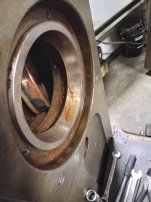VICTORY!!!!

At least in the sense that the spindle has left the column! Lots of evenings just looking at it and thinking about where to apply pressure, then tonight some persistent nudges at different angles on various pieces along the spindle and one by one they were becoming loose as the spindle came forward. Lastly I was able to bolt a pulley puller to the back of the spindle (the kind that looks like a peace sign) and use that to push the spindle the last little bit out.


Now that it's out, It's obvious where my problems lie. Lots of ugly orange sludge in the inside taper bearing leading to some pitted lines and fret marks. Cleaning all this up should make reassembly and any future disassembly easier. I think I could have been safe thoroughly flushing it out and halted the damage, but it would have had to come apart to fix the 'crunch'. Otherwise I was thinking about naming this mill 'Cap'n Crunch.'
Now to the next phase: I can now see the reason the manual tells you to remove the shaft bellow the spindle is because there's no room to remove most of the pieces that fit over the spindle. With some twisting and trickery I was able to remove everything but the big bull gear and the inner bearing race, which simply can't come out unless I get some room under them. So next I need to make another spanner socket to get that lower shaft apart, then after it's apart I can press in the new bearing race and start reassembling the spindle (as it get's cleaned of the rust and a few nicks pieces obtained during removal. Nothing broken though!). The front bearing and it's race, and the bearing assembly on the tail end of the spindle both look and feel fine, so I'm only going to replace the damaged one and save the other bearings for later.
Found a date on the tail bearing too.

7-4-45 I think confirms that this mill saw major repairs after its birth in 36'. I think it also effectively proves this mill was a WW2 combat veteran in its own way. While I have profound respect for soldiers and those who went through hell on the front line, I think too often we forget about the hero's back home who worked miracles to keep our soldiers supplied with the most and best gear possible. I get a little emotional when I see warbirds, tanks and other surviving relics from that time because to me they're a testament of a nation that was unified in a cause, because regardless of the politics, everyone wanted to do their part so their sons and daughters could come home and leave the other side of the world a better freer place. It's sad that that unification isn't with us any more, but 'war finish' machines like this mill to me are another monument of that home front effort and deserve some respect. To think how much work this mill did in 9 or so years to wear out it's bearings marks it a machine-shop hero in it's own little way.
I remember when I first read about what happened at Pearl Harbor, it blew me away. We learned in school about the terrible attack, the loss of life and how it spurred America on to defend itself, but man-oh-man they didn't teach us the coolest part of how (with a couple exceptions such as the Arizona) the ships that were 'lost' in the attack were all floated and repaired in a ridiculously short amount of time! We didn't just leave them all sunk and accepted Japan's victory. That home front support is what makes me tear up. It's all just a bunch of metal and iron, but who made it work and fixed it so the hero's could do what needed to be done? Those people are hero's in my book too, and the pieces that survive today are that much cooler because of it.





